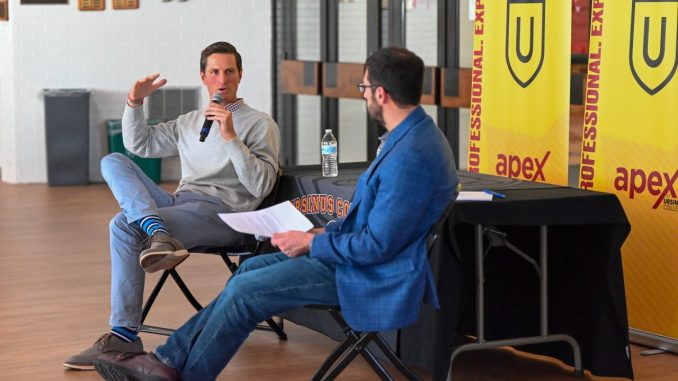
The bright lights shine down on the gym, fit for the moment at hand. I had sat down for the final four minutes of a game in my local athletic center’s youth basketball league, the gym packed shoulder-to-shoulder. You could feel the intensity radiating from the court; sweat dripping, play calls being screamed, the sounds of the dribble of the ball echoing through the room. It’s a moment that would be overwhelming for anyone, especially a young athlete. The catch? The game was just the first of four the athletes would play that day.
The image is seen across the country, in a variety of sports. Ridiculous “tournaments” with multiple games played, constant pressure placed on the athletes, and even actual corruption are seen quite often in the youth sports world. Basketball, however, has become a primary offender, with former Lakers’ strength and conditioning coach Tim DiFrancesco once famously referring to the process as turning kids into “ticking time bombs.” It’s the reason why Ursinus Hall-of-Famer Dennis Stanton 04’, who runs a local basketball program in Montgomery County, has looked to adopt a new philosophy. The former Bears’ guard, who also serves as Athletic Director at Souderton Area High School, visited campus for a talk hosted by Professor Doron Taussig on October 22nd, discussing his strategies for developing great players, and great leaders, in today’s youth sports landscape.
“We look to keep it about development [of the kids], keep it about the process,” Stanton told a small crowd gathered in the Floy Lewis Bakes Center.
Stanton’s ideas stand out as a potential path to success for young athletes in youth basketball, both on and off the court.
There are many ways in which the amount of pressure placed on young athletes can affect their overall health off the court. Stanton, however, was also quick to point out how the pressure and competitiveness do not aid young players’ development on the court.
The former Bear alluded to the movement of coaches utilizing a “full-court-press” defense often in youth basketball, looking to constantly force the ball out of the hands of the opponent by pressuring them all the way up the court. The strategy is largely effective, given most young children aren’t able to have the dribbling and handling skills of a professional at a young age. To Stanton, however, the tactic stilts growth for young players offensively through not allowing them to practice shooting and driving.
“What are we preparing them for [with this tactic]?,” Stanton asked. “It’s an absolute disaster brand of basketball, and nobody’s having fun.”
The program director also alluded to the fact that he looks to play his players more evenly than other programs at a young age, sometimes pulling his best young athletes in crucial moments of the game.
“I can sleep at night with the decision, knowing that the ninth best player on the team has some self-efficacy about basketball and about life,” Stanton said.
Stanton admits both strategies have likely cost him wins within the youth basketball circuit. But he emphasized that the experience was about more than just securing victory, a very different mindset than many other programs.
“If the work becomes based on outcomes and results, it becomes hollow,” Stanton said.
The industrial nature of youth basketball certainly prohibits its players from growing during games in America. But elsewhere across the world, many flourish without the same standards, according to Stanton.
“If you look at foreign basketball in general, it’s infiltrated the NBA,” he pointed out. “It’s really showing where skills can undermine athleticism.”
Many critics of America’s system, including the late Kobe Bryant, emphasize that European basketball programs are often pointed to as more focused on fundamentals and learning the intricacies of the game from a young age. The formula has certainly led to success, as stars like Giannis Antetokounmpo and Nikola Jokic dominate television screens on a nightly basis. Stanton hopes to infuse some of the same ideas into his program.
The system tends towards kids learning how to become more skilled basketball players, rather than having to memorize a large volume of plays and actions.
“The pendulum has swung so far in learning all these plays, that these kids are never going to learn the proper skills,” Stanton said. “We have it all backwards.”
Through a focus on the core skills, Stanton’s hope is to instill a balance between the competitive edge of American youth basketball, and the skills needed to grow.
Stanton’s ideas look to put his athletes in a situation to succeed, trying to escape the trappings of American youth basketball. But the program director was quick to point out that success in the sport is still defined by the effort of the athlete.
“There has to be an internal hunger,” Stanton said. “Unless you’re a freak athlete, it takes a lot of individual reps to be good at anything.”
The hope is that the values which his program looks to instill will make the sport more enjoyable for the youth, inciting the “hunger” within.
“We want all these kids to flourish,” Stanton said. “That’s something we’ll celebrate.”
